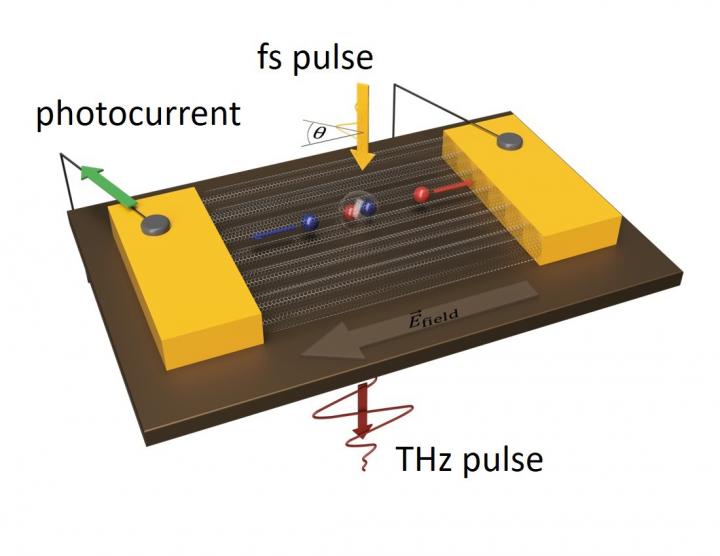Terahertz science discloses the ultrafast photocarrier dynamics in carbon nanotubes

The schematic diagram of CNT-based photoconductive antenna switch and experimental set-up. The CNT tubes are aligned parallel to the direction of applied electric field. Credit: @2020 American Chemical Society
Carbon nanotubes (CNTs), a model one-dimensional (1D) material made up entirely of carbon atoms, have attracted considerable attention ever since their discovery because of the unique properties arising from quantum confinement effects.
CNTs have been labeled as one of the materials for next-generation optoelectronic devices. Critical towards this advancement is understanding how quasiparticles – theoretical particles used to describe observable phenomena in solids – behave and interact with each other in a 1D system.
This requires a fundamentally different model compared to a conventional 3D material like silicon as a consequence of the reduced dimensionality in CNTs.
“It was difficult to develop a terahertz radiation device with an external high electric field in a specific direction to CNT,” says corresponding author Masayoshi Tonouchi.
By combining different experimental techniques, the team was able to directly probe the creation of free charge carriers in CNTs at different time scales after photoexcitation.
Very complex interactions that involve different quasiparticles occur after the initial photoexcitation. These processes change over time, and being able to probe one of the quasiparticles makes it easier to understand the whole process.
Together with state-of-the-art simulations, the team was able to identify two key mechanisms that explain their data and helped them develop a detailed microscopic model describing quasiparticle interactions in a strong electric field in CNTs.
“We proposed a model in which electron-hole bound quasiparticles excited in the high energy E22 exciton band diverge to the low energy band and play a role in ultrafast electrical conduction. This model successfully explained the experimental facts and led to the clarification of the physical properties of CNTs.”
Their results shed light on a number of long-standing issues in CNT ultrafast dynamics, moving us closer towards the realization of advanced optoelectronics based on CNTs and other low-dimensional materials.
###
The article, “Terahertz Excitonics in Carbon Nanotubes: Exciton Autoionization and Multiplication,” was published in ACS Nano Letters at DOI: https:/
About Osaka University
Osaka University was founded in 1931 as one of the seven imperial universities of Japan and now has expanded to one of Japan's leading comprehensive universities. The University has now embarked on open research revolution from a position as Japan's most innovative university and among the most innovative institutions in the world according to Reuters 2015 Top 100 Innovative Universities and the Nature Index Innovation 2017. The university's ability to innovate from the stage of fundamental research through the creation of useful technology with economic impact stems from its broad disciplinary spectrum.
Website: https:/
Media Contact
More Information:
http://dx.doi.org/10.1021/acs.nanolett.9b05082All latest news from the category: Physics and Astronomy
This area deals with the fundamental laws and building blocks of nature and how they interact, the properties and the behavior of matter, and research into space and time and their structures.
innovations-report provides in-depth reports and articles on subjects such as astrophysics, laser technologies, nuclear, quantum, particle and solid-state physics, nanotechnologies, planetary research and findings (Mars, Venus) and developments related to the Hubble Telescope.
Newest articles

How marine worms regenerate lost body parts
The return of cells to a stem cell-like state as the key to regeneration. Many living organisms are able to regenerate damaged or lost tissue, but why some are particularly…

Nano-scale molecular detective
New on-chip device uses exotic light rays in 2D material to detect molecules. Researchers have developed a highly sensitive detector for identifying molecules via their infrared vibrational “fingerprint”. Published in Nature…

Novel CAR T-cell therapy
… demonstrates efficacy and safety in preclinical models of HER2-positive solid tumors. The p95HER2 protein is found expressed in one third of HER2+ tumors, which represent 4% of all tumors….



